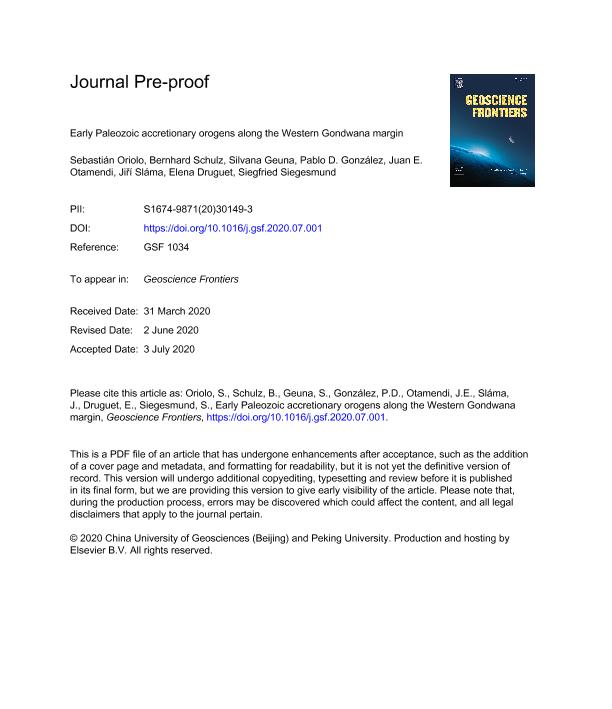Mostrar el registro sencillo del ítem
dc.contributor.author
Oriolo, Sebastián

dc.contributor.author
Schulz, Bernhard

dc.contributor.author
Geuna, Silvana Evangelina

dc.contributor.author
Gonzalez, Pablo Diego

dc.contributor.author
Otamendi, Juan Enrique

dc.contributor.author
Sláma, Jiří
dc.contributor.author
Druguet, Elena
dc.contributor.author
Siegesmund, Siegfried

dc.date.available
2021-08-10T16:29:20Z
dc.date.issued
2021-01
dc.identifier.citation
Oriolo, Sebastián; Schulz, Bernhard; Geuna, Silvana Evangelina; Gonzalez, Pablo Diego; Otamendi, Juan Enrique; et al.; Early Paleozoic accretionary orogens along the Western Gondwana margin; Elsevier B.V.; Geoscience Frontiers; 12; 1; 1-2021; 109-130
dc.identifier.issn
1674-9871
dc.identifier.uri
http://hdl.handle.net/11336/138095
dc.description.abstract
Early Paleozoic accretionary orogens dominated the Western Gondwana margin and were characterized by nearly continuous subduction associated with crustal extension and back-arc basin development. The southwestern margin is represented by Famatinian and Pampean basement realms exposed in South America, both related to the protracted Paleozoic evolution of the Terra Australis Orogen, whereas the northwestern margin is mainly recorded in Cadomian domains of Europe and adjacent regions. However, no clear relationships between these regions were so far established. Based on a compilation and reevaluation of geological, paleomagnetic, petrological, geochronological and isotopic evidence, this contribution focuses on crustal-scale tectonic and geodynamic processes occurring in Western Gondwana accretionary orogens, aiming at disentangling their common Early Paleozoic evolution. Data show that accretionary orogens were dominated by high-temperature/low-pressure metamorphism and relatively high geothermal gradients, resulting from the development of extended/hyperextended margins and bulk transtensional deformation. In this sense, retreating-mode accretionary orogens characterized the Early Paleozoic Gondwana margin, though short-lived pulses of compression/transpression also occurred. The existence of retreating subduction zones favoured mantle-derived magmatism and mixing with relatively young (meta)sedimentary sources in a thin continental crust. Crustal reworking of previous forearc sequences due to trenchward arc migration thus took place through assimilation and anatexis in the arc/back-arc regions. Therefore, retreating-mode accretionary orogens were the locus of Early Paleozoic crustal growth in Western Gondwana, intimately associated with major flare-up events, such as those related to the Cadomian and Famatian arcs. Slab roll back, probably resulting from decreasing convergence rates and plate velocities after Gondwana assembly, was a key factor for orogen-scale geodynamic processes. Coupled with synchronous oblique subduction and crustal-scale dextral deformation, slab roll back might trigger toroidal mantle flow, thus accounting for bulk dextral transtension, back-arc extension/transtension and a large-scale anticlockwise rotation of Gondwana mainland.
dc.format
application/pdf
dc.language.iso
eng
dc.publisher
Elsevier B.V.
dc.rights
info:eu-repo/semantics/openAccess
dc.rights.uri
https://creativecommons.org/licenses/by-nc-sa/2.5/ar/
dc.subject
CADOMIAN
dc.subject
CRUSTAL GROWTH
dc.subject
FAMATINIAN
dc.subject
HF ISOTOPIC ARRAY
dc.subject
LOWER PALEOZOIC
dc.subject
RETREATING ACCRETIONARY OROGEN
dc.subject.classification
Geología

dc.subject.classification
Ciencias de la Tierra y relacionadas con el Medio Ambiente

dc.subject.classification
CIENCIAS NATURALES Y EXACTAS

dc.title
Early Paleozoic accretionary orogens along the Western Gondwana margin
dc.type
info:eu-repo/semantics/article
dc.type
info:ar-repo/semantics/artículo
dc.type
info:eu-repo/semantics/publishedVersion
dc.date.updated
2021-04-23T16:41:11Z
dc.journal.volume
12
dc.journal.number
1
dc.journal.pagination
109-130
dc.journal.pais
China

dc.description.fil
Fil: Oriolo, Sebastián. Consejo Nacional de Investigaciones Científicas y Técnicas. Oficina de Coordinación Administrativa Ciudad Universitaria. Instituto de Geociencias Básicas, Aplicadas y Ambientales de Buenos Aires. Universidad de Buenos Aires. Facultad de Ciencias Exactas y Naturales. Instituto de Geociencias Básicas, Aplicadas y Ambientales de Buenos Aires; Argentina
dc.description.fil
Fil: Schulz, Bernhard. Technische Universität Bergakademie Freiberg; Alemania
dc.description.fil
Fil: Geuna, Silvana Evangelina. Consejo Nacional de Investigaciones Científicas y Técnicas. Oficina de Coordinación Administrativa Ciudad Universitaria. Instituto de Geociencias Básicas, Aplicadas y Ambientales de Buenos Aires. Universidad de Buenos Aires. Facultad de Ciencias Exactas y Naturales. Instituto de Geociencias Básicas, Aplicadas y Ambientales de Buenos Aires; Argentina
dc.description.fil
Fil: Gonzalez, Pablo Diego. Consejo Nacional de Investigaciones Científicas y Técnicas; Argentina. Universidad Nacional de Río Negro. Sede Alto Valle. Instituto de Investigaciones en Paleobiología y Geología; Argentina
dc.description.fil
Fil: Otamendi, Juan Enrique. Universidad Nacional de Río Cuarto. Facultad de Ciencias Exactas Fisicoquímicas y Naturales. Instituto de Ciencias de la Tierra, Biodiversidad y Ambiente - Consejo Nacional de Investigaciones Científicas y Técnicas. Centro Científico Tecnológico Conicet - Córdoba. Instituto de Ciencias de la Tierra, Biodiversidad y Ambiente; Argentina
dc.description.fil
Fil: Sláma, Jiří. The Czech Academy of Sciences. Institute of Geology; República Checa
dc.description.fil
Fil: Druguet, Elena. Universitat Autònoma de Barcelona; España
dc.description.fil
Fil: Siegesmund, Siegfried. Universität Göttingen; Alemania
dc.journal.title
Geoscience Frontiers
dc.relation.alternativeid
info:eu-repo/semantics/altIdentifier/url/https://linkinghub.elsevier.com/retrieve/pii/S1674987120301493
dc.relation.alternativeid
info:eu-repo/semantics/altIdentifier/doi/http://dx.doi.org/10.1016/j.gsf.2020.07.001
Archivos asociados
